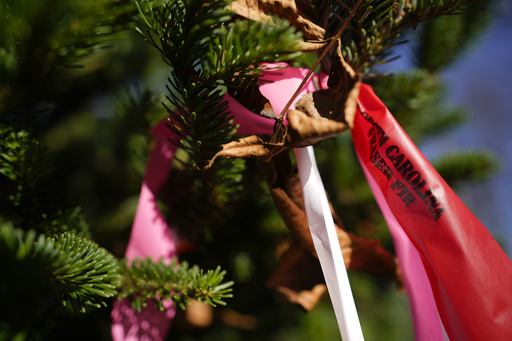
NEWLAND, N.C. — For the Cartner family, the anticipation of one of their Christmas trees gracing the White House has been in the works since last year. However, their plans faced a setback when Hurricane Helene delivered a brutal blow to western North Carolina and Avery County, home to Cartner’s Christmas Tree Farm, which has been a staple in the area for decades. The family lost thousands of trees due to a devastating mudslide, yet, amid the destruction stood a majestic 20-foot tree that towers above others on the expansive property.
This remarkable tree is set to be cut down and transported via crane on a truck headed for Washington, D.C. “We wanted to be a source of inspiration for other farmers and residents in western North Carolina who have faced significant losses,” explained Sam Cartner Jr., one of three sibling-owners of the farm.
As he made his way through the back of the farm, where the chosen tree is located, the devastation of Helene is not immediately apparent. Rows of deep green trees stand resilient against the lighter, rolling hills, accompanied only by the sounds of chirping birds and the gentle rustle of leaves in the breeze. However, the situation becomes clearer as Cartner returns to the front areas of the property, revealing signs of destruction—an entire section of a grassy slope appears as if it has been gouged out, exposing barren earth due to a mudslide that claimed between 5,000 to 6,000 smaller trees. While the loss is concerning, Cartner noted that the affected trees were not ready for harvest this season, so the impact was manageable.
The storm also caused significant damage to various features of the farm, such as culverts and gullies, making access to certain areas hazardous. It took several weeks to repair the twisting dirt roads across the farm. “Thankfully, we’re expecting a fairly normal harvest,” Cartner shared, adding that others may not be so fortunate.
Jennifer Greene, the executive director of the North Carolina Christmas Tree Association, highlighted that the primary concern for growers across the region revolves around repairing their infrastructure in the wake of the storm. Although some tree losses were incurred, Greene remained optimistic, noting that the farmers, who collectively harvest between four to five million Christmas trees annually, are resilient and determined to adapt. “They find ways to make it work; it’s in their nature,” she stated.
The history of Cartner’s Christmas Tree Farm dates back to 1959 when Sam and Margaret Cartner launched the farm, specializing in Fraser firs—a species native to the Appalachian region. Initially, they cultivated a variety of crops alongside the trees, opting to plant them on less desirable land. Over the years, the farm has expanded to encompass around 500 acres, focusing primarily on wholesale sales to garden centers and stores nationwide. The operation has evolved significantly, employing seasonal workers from Mexico to assist with year-round maintenance.
The labor process is intensive, with each tree typically going through over 100 manual touches before reaching the consumer. Recently, the farm achieved the distinction of being named the grand champion at the National Christmas Tree Association’s contest for 2024, which mandates that the winning farm provide the official Christmas tree for the White House.
The White House staff’s visit to the farm to select the tree was initially postponed due to the damage inflicted by Helene. However, when they finally arrived in late October, they chose a tree adorned with a large red, white, and blue ribbon. The selected tree, approximately 25 years old and weighing between 400 to 500 pounds, is so substantial that a crane will be necessary for its transport. Cartner noted the tree’s vibrant color and robust limbs as contributing factors to its selection, in addition to being “kid-friendly” in terms of size for family gatherings.
The Cartner family looks forward to presenting the tree to First Lady Jill Biden in front of the White House and plans to return in December to see the decorated tree in the Blue Room.
Even amid the excitement surrounding the honor of contributing to the White House’s Christmas festivities, Cartner expressed a desire to move forward. The storm has cast a long shadow over an already challenging harvest season, with pressures mounting as they try to navigate the complexities of logistics and preparations. “Managing the shipping of such a large volume of trees within just a few weeks, stacked on top of everything else, can feel truly overwhelming,” he admitted.
Preparations are already underway for the next year, which brings its own challenges, such as sourcing new seedlings after Helene destroyed some greenhouses. Additionally, administrative tasks must be addressed to bring back seasonal workers, and orders for essential supplies are critical.
This operation has evolved significantly since its humble beginnings with Cartner’s parents. While they might not have sought the spotlight, he believes they would be proud to represent western North Carolina during such a difficult time following the hurricane. Cartner concluded, “This tree symbolizes faith, hope, love, joy, and the sense of community that we should cherish.”
